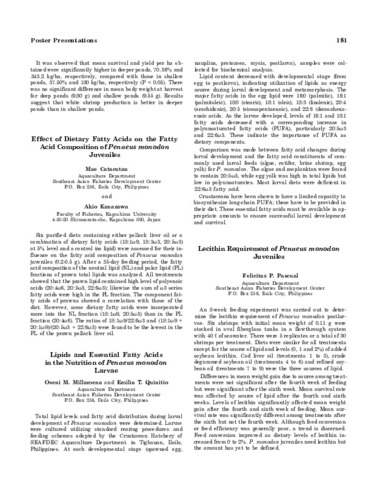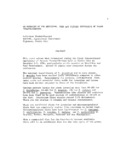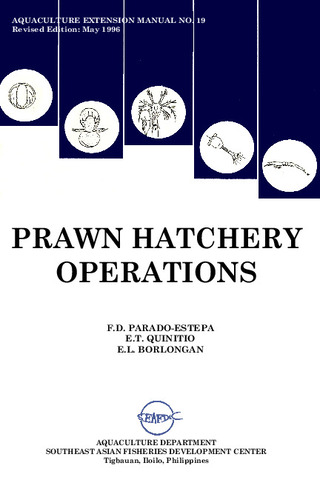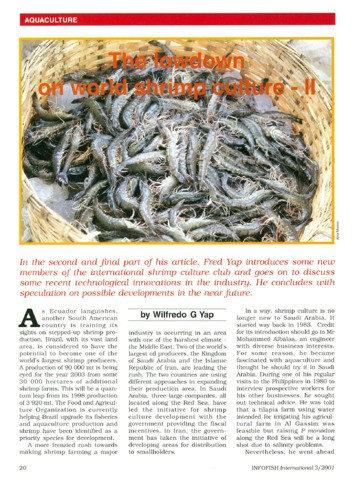Lipids and essential fatty acids in the nutrition of Penaeus monodon larvae
Share
Abstract
Total lipid levels and fatty acid distribution during larval development of Penaeus monodon were determined. Larvae were cultured utilizing standard rearing procedures and feeding schemes adopted by the Crustacean Hatchery of SEAFDEC Aquaculture Department in Tigbauan, Iloilo, Philippines. At each developmental stage (spawned egg, nauplius, protozoea, mysis, postlarva), samples were collected for biochemical analysis.
Lipid content decreased with developmental stage (from egg to postlarva), indicating utilization of lipids as energy source during larval development and metamorphosis. The major fatty acids in the egg lipid were 16:0 (palmitic), 16:1 (palmitoleic), 18:0 (stearic), 18:1 (oleic), 18:3 (linolenic), 20:4 (arachidonic), 20:5 (eicosapentaenoic), and 22:6 (docosahexa-enoic acids. As the larvae developed, levels of 16:1 and 18:1 fatty acids decreased with a corresponding increase in polyunsaturated fatty acids (PUFA), particularly 20:5ω3 and 22:6ω3. These indicate the importance of PUFA as dietary components.
Comparison was made between fatty acid changes during larval development and the fatty acid constituents of commonly used larval feeds (algae, rotifer, brine shrimp, egg yolk) for P. monodon. The algae and zooplankton were found to contain 20:5ω3, while egg yolk was high in total lipids but low in polyunsaturates. Most larval diets were deficient in 22:6ω3 fatty acid.
Crustaceans have been shown to have a limited capacity to biosynthesize long-chain PUFA; these have to be provided in their diet. These essential fatty acids must be available in appropriate amounts to ensure successful larval development and survival.
Description
Abstract only.
Suggested Citation
Millamena, O. M., & Quinitio, E. T. (1985). Lipids and essential fatty acids in the nutrition of Penaeus monodon larvae. (Abstract only). In Taki Y., Primavera J.H. and Llobrera J.A. (Eds.). Proceedings of the First International Conference on the Culture of Penaeid Prawns/Shrimps, 4-7 December 1984, Iloilo City, Philippines (p. 181). Iloilo City, Philippines: Aquaculture Department, Southeast Asian Fisheries Development Center.
Taxonomic term
Related items
Showing items related by title, author, creator and subject.
-
An overview of the nutrition, feed and feeding techniques of prawn penaeid/shrimps
Piedad-Pascual, Felicitas (Philippine Council for Aquatic and Marine Research and Development, 1989)This paper echoes what transpired during the first International Conference of Penaeid Prawns/Shrimps held in Iloilo City in December 4-7, 1984, particularly on the Nutrition nd Feed Development. Around 25 papers were ... -
Prawn hatchery operations
Parado-Estepa, Fe D.; Quinitio, Emilia T.; Borlongan, Emeterio L. (Aquaculture Department, Southeast Asian Fisheries Development Center, 1996-05)The manual, an updated version of the 1984 SEAFDEC/AQD manual, presents the underlying principles and step-by-step instructions of prawn larval and post-larval rearing. The techniques described are not only applicable to ... -
The lowdown on world shrimp culture - II
Yap, Wilfredo G. (INFOFISH, 2001)This paper introduces some new members of the international shrimp culture club and goes on to discuss some recent technological innovations in the industry, particularly the polyculture of tilapia (mainly Oreochromis ...





